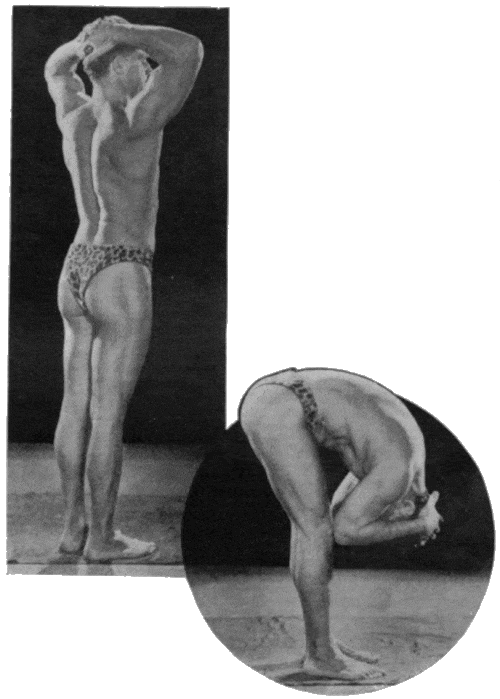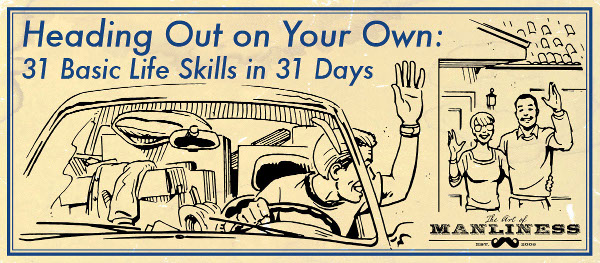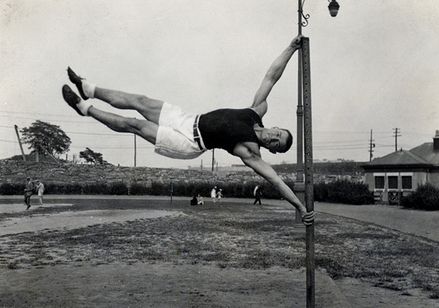
This article series is now available as a professionally formatted, distraction free paperback or ebook to read offline at your leisure.
Editor’s Note: This article was originally published on August 25, 2012. It has since been updated.
When I was in high school, I didn’t have to worry about creating and sticking to a fitness routine. I had football coaches who took care of that for me. I just had to show up at the weight room at the designated time with the rest of my teammates and do the scheduled workout. Because of that consistency, along with a lot of hard work, I was in really good shape when I graduated and headed off to college.
With my football days behind me, I pretty much stopped working out once I arrived on campus. I’d play the occasional pick-up basketball game, but I didn’t have a set fitness routine to maintain the strength and conditioning I achieved while in high school. Boy, did things deteriorate quickly for me. I started to get soft and pudgy and my strength was nowhere near the levels I was used to. I remember one night during my freshman year in college I decided to go to the gym in an attempt to get back on track. I slapped 225 lbs on the bench barbell to start off. It was a weight I had easily lifted in high school. I lifted the barbell off the rack and began to slowly lower it to my chest…where it stayed until my cries of help were heard. Thankfully, only my ego was bruised. But that moment really spurred me to get back on the fitness bandwagon.
I’ve noticed that a lot of young men heading out on their own fall into the same trap I did. Sometimes they were physically active in high school because of sports, but as soon as they head off to college they stop exercising completely and quickly become the stereotypical fat ex-jock. Don’t let this happen to you! It’s harder to get back into shape once you’ve gotten flabby than it is to maintain the shape you’re already in. That’s why it’s so important you keep a regular exercise routine when you head out on your own.
If you didn’t exercise regularly in high school, without working out (and a healthy diet) you won’t become a fat ex-jock, you’ll just become fat. Plenty of guys who maintained an average weight in college find themselves growing a belly as they move into their mid and late 20s — a diet of fast food and plenty of beer takes its toll.
When I went with Kate to her ten year high school reunion, I was struck by the fact that while most of the women seemed to have maintained their figures (despite some of them having children), the dudes looked pretty out of shape and overweight.
The first few years living out on your own will a build a foundation for the rest of your life, so unless you want to become the middle-aged guy who gets all wheezy when playing with his kids, now is the time to establish a fitness routine for yourself.
Why You Need a Fitness Routine
1. Increases testosterone. Testosterone is what makes men, men. Unfortunately, most young men have lower testosterone than their grandfathers did because of changes in diet, activity levels, and chemicals in our environment, water, and food supply. The benefits of optimal testosterone levels are numerous. Besides increasing your libido, testosterone does the following:
- increases mental and physical energy
- boosts happiness (men with low-T often suffer depression)
- increases competitive drive
- helps prevent Alzheimer’s and dementia
- increases muscle size and strength
Compound weight lifting exercises like squats, bench press, cleans, and deadlifts are great testosterone boosters. High intensity exercises, like sprinting, have been shown to boost testosterone levels as well.
2. Good for your brain. If you want to be a stellar college student, you need to hit the treadmill in addition to hitting the books. Studies show that regular exercise speeds learning, improves memory, and promotes clearer thinking.
3. Increases your willpower. We’ve talked about the importance of willpower in our success as men. One way to strengthen it is to make regular exercise a habit. Working out will increase your discipline in all areas of your life.
4. Reduced health costs. Health costs are ballooning here in the U.S. because of the rise of obesity and obesity-related diseases like diabetes, heart disease, and hypertension. While proper diet plays the biggest role in preventing obesity, regular exercise can help stave off weight gain and improve how your body uses insulin so you don’t get diabetes. A regular fitness routine has also been shown to reduce blood pressure and improve heart health. If you don’t want to spend a small fortune treating these ailments in the future, get in the gym today. Not only will you reduce your own health care costs by being physically fit, you can take some manly pride knowing you’re not increasing costs for your neighbors and fellow citizens.
5. Relieves stress and depression. We’re going to go into more detail about managing stress next week, but one thing you can start doing today that will go a long way to keeping you chill like The Dude is to exercise. It releases endorphins in your brain, improves sleep, and can relieve feelings of anxiety and depression. Exercising regularly is truly one of the most important things you can do to stay sane during college.
6. Makes you physically attractive. Your physical attractiveness can play a big role in your personal and professional success. Women are more attracted to men who are fit and in shape. Men who are physically attractive often report higher incomes and more job promotions than men who are less attractive. Exercise can help mold a physique that will make you attractive to others, and even more importantly, boost your confidence in yourself.
Establishing an Exercise Routine

A lot of men know it’s important to exercise, but end up feeling lost as to what to do for their workout. There are so many opinions out there as to what the “best” workout is that you can end up feeling overwhelmed and not doing anything at all. When I’d go to the gym at OU, I’d often see guys just kind of wandering around aimlessly, half-hardheartedly doing a few bicep curls and tricep extensions.
In truth, at least in my opinion, unless your fitness goal is to get super shredded or have a bodybuilder’s physique, you shouldn’t stress about finding the “perfect” workout. Instead, focus on improving your overall strength and fitness with a routine that’s as simple as possible – one you will enjoy and do consistently. The most important thing is to do something, anything, to move your body every day!
Below I suggest two exercise routines that are perfect for a young man who is busy, but is looking to maximize results. One requires access to a gym and free-weights, while the other consists solely of bodyweight exercises.
1. Starting Strength
My favorite workout routine is the Starting Strength by Mark Rippetoe. It’s fast (workouts take about 40 minutes), you don’t need much equipment, it produces great results, and it’s very doable for a beginner who’s new to lifting. I also like it because it’s similar to the strength training program I did as a high school football player. I’m stronger and leaner than I’ve ever been since starting Starting Strength.
You an find the breakdown of the program at Starting Strength.
2. Bodyweight Workout
This bodyweight program is one I do sometimes when I can’t or don’t want to go to the gym. It works your entire body and can be done anywhere. The only equipment this routine requires is an Iron Gym Pull-Up Bar that you can place in any doorframe and which doesn’t require you to drill any holes. Even if you plan on going to the gym regularly, buying an Iron Gym Pull-Up Bar is a great investment for any young man. Make it a policy to crank out a few pull-ups each time you pass through the doorframe from which it hangs.
Even if you can’t swing an Iron Gym bar, I’m sure you could find a tree branch or another bar that could be used for pull-ups. Or you can sub in a bodyweight row. Let Steve Kamb from Nerd Fitness show you how (he’s got great beginner and advanced bodyweight workouts on his site for more ideas too):
This is a circuit program, meaning you do each of the exercises back-to-back without any rest. When you’ve completed all the exercises, you’ve completed one circuit. The exercises link to how-to videos for those who haven’t done them before.
- Squats: 20 reps
- Push-ups: 10 reps
- Hindu push-ups: 10 reps
- Walking Lunges: 20 reps
- Pull-ups: 5 reps
- Dips: 15 reps
Do a ten minute warm-up first (jumping jacks, jump rope, jogging), and then complete each exercise back-to-back without resting. That’s a circuit. Rest for two minutes after completing a circuit and then start another one.
Start with one circuit, and then add a circuit once you’re able to perform all the reps for all the exercises. Keep adding circuits until you can complete all the reps for all the exercises for five circuits. After that, start adding 1 rep to each exercise at each workout.
Perform this workout every other day, three times a week. Here’s a suggested schedule:
- Monday: Bodyweight workout
- Tuesday: Sprints or plyometrics
- Wednesday: Bodyweight workout
- Thursday: 5K run
- Friday: Bodyweight workout
- Saturday: Rest
- Sunday: Rest
Whatever workout program you choose, the key is to be consistent with it. Treat your workouts like an important doctor’s appointment. When you plan your week, block off a time each day for exercise.
You should also look for ways to incorporate exercise into your everyday life – walk and bike to campus when you can, join an intramural team, play some pick-up games of ultimate Frisbee with your buds, and take a date on a bike ride. Establishing a habit of regular exercise – both at the gym and throughout your day — will reap enormous benefits for the rest of your life.
Be sure to listen to our podcast on making exercise a sustainable habit:







